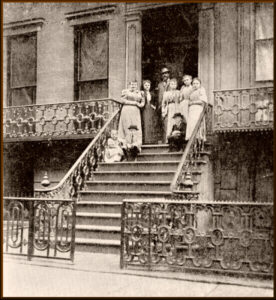Module 1: Dvořák as Other
 Module Introduction
Module Introduction
This module explores how Dvořák’s career was shaped by his Czech identity and how his national difference influenced his perspective as he composed and taught in the United States. In exploring Dvořák’s Symphony No. 9 From the New World, the composer’s position as Other in the U.S. emerges in relation to the American musical landscape at the end of the nineteenth century. This case study illuminates national difference, and how it is manifested in the symphonic tradition.
A Czech Background
Nineteenth-century Czech composers, like Dvořák and Bedřich Smetana, developed a musical style that relied on rural folk-idioms, however stereotypical, to distinguish their music from their Western European counterparts, however stereotypical. Dvořák knew, however, that using actual Czech folk melodies could be perceived as sounding simplistic and derivative by his audiences, and so he created a Czech-inspired musical idiom for his melodies. Because they were from a less recognized European background, these composers were compelled to “Other” themselves (or cast themselves as different) in the field of European classical music in order to have their music be valued as an original creation. This method of othering through foregrounding national musical characteristics may have inspired Dvořák’s approach to creating his version of an American musical language.
An American Sound
As mentioned in the Introduction, Dvořák came to America at the invitation of Jeanette Thurber with the goal of developing an American school of composition. Dvořák was an obvious choice for a composer in residence because Thurber admired how he had brought Czech music into the mainstream. She hoped he could do the same for American music.
Although American composers, such as William Henry Fry, Louis Moreau Gottschalk, George Whitfield Chadwick, and Amy Beach, were writing symphonic works at the time, too, today their music does not carry the same sustained popularity in the U.S. as Dvořák’s Symphony No. 9 From the New World. In his symphony, the composer wanted to include African American and Native American idioms to forge a genuine American music. In a manner similar to how he had written Czech folk-inspired themes, he composed melodies that encapsulated what he considered an authentic expression of American folk culture. This choice was controversial among some other American composers such as Chadwick and Beach who thought drawing from European idioms would be more authentic to American immigrant cultures and their lived experience. Even though Dvořák was loosely inspired by these American musical traditions, he was familiar only with a small amount of these rich musical traditions, mainly in the form of spirituals that his student Harry T. Burleigh sang for him. Therefore, his musical idioms draw on exotic stereotypes.
Dvořák’s position as a Czech composer in America gave him a different perspective on the cultural landscape. However, his limited time in the U.S. meant that his American-inspired thematic material was more rooted in stereotypical interpretation than in actual observation.
Primary Sources
Beach, Amy. “American Music,” Boston Herald, May 28, 1893.
Amy Beach questions Dvořák’s use of African American and Native American melodies to represent American music.
Dvořák, Antonín, “Music in America,” Harper’s New Monthly Magazine (February 1895), 429-434.
Secondary Sources
Beckerman, Michael, ed. Dvorak and His World. Princeton University Press. 1993.
Campo-Bowen, Christopher. “A Promising, Political Sound”: Epistemologies of Empire and Bedřich Smetana’s The Bartered Bride at the 1892 Vienna International Exhibition of Music and Theater,” The Musical Quarterly 102 (2019): 31-81.
Gelbart, Matthew. The Invention of ‘Folk Music’ and ‘Art Music’: Emerging Categories from Ossian to Wagner. New Perspectives in Music History and Criticism. Cambridge: Cambridge University Press. 2007.
Hepokoski, James. “Culture Clash. James Hepokoski Revisits Dvořák’s New World Symphony.” The Musical Times 134 (1993): 685-88.
Shadle, Douglas W. Orchestrating the Nation: The Nineteenth-Century American Symphonic Enterprise. New York: Oxford University Press, 2016.
Sikand-Youngs, Nathaniel. “‘Another Spirit, Other Thoughts, Another Colouring’: Performances of Race in Antonín Dvořák’s Symphony no. 9 from the New World.” HJEAS: Hungarian Journal of English and American Studies 23/ 2 (2017): xx-vv.
Investigations
Listening:
1) Dvořák Symphony no. 9 From the New World https://www.youtube.com/watch?v=VuaTY3zHO8Q
Listen for how the motive in the first movement is used throughout the other movements. Dvořák composed the African American and Native American inspired melodies based on the pentatonic scale which is noticeable particularly in the second and third movements.
Dvořák’s String Quartet No. 12 “American” https://www.youtube.com/watch?v=HrqgMrwG4i0
Similar musical idioms to the Symphony No. 9 are used in this string quartet. The melodies are African American-inspired and based on the pentatonic scale. In the third movement, there is a bird call sound supposedly transcribed from one Dvořák heard in America.
Dvořák’s Czech Suite in D Major https://www.youtube.com/watch?v=7-BfYeeoJ3U
Compare the Czech-style music in this suite to what you hear in the American-inspired pieces. This piece was written in 1879, more than a decade before his journey to the U.S.
2) Dvořák’s Symphony No. 9 From the New World has been used in many different settings, such as commercials, cartoons, and popular media. Pleas listen to the second movement used in this British commercial and to the drum corps Phantom Regiment’s performance of the fourth movement, and compare how these versions use the symphony and its associated meanings. How is Americanness represented in these examples and any other examples you may know of?
Critical Thinking:
Can you find other examples where this symphony is used, including mashups and re-mixes? What does this work signify? Americanness? Class?
In what ways does Dvořák’s experience writing a symphony compare to that of Florence Price whose work is discussed in another unit?
